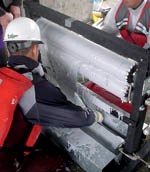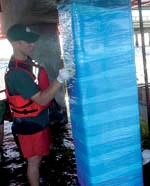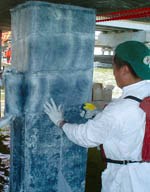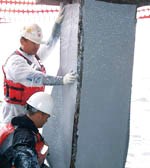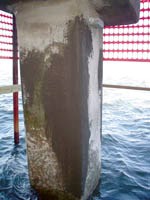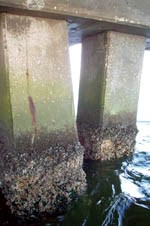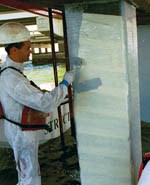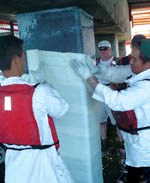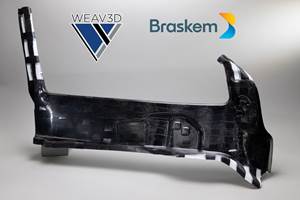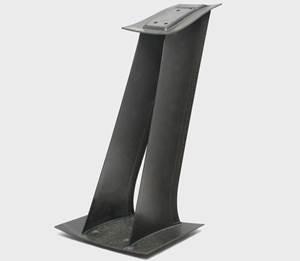Composites Cut Costs Of Repairing Corrosion-Prone Systems
Composites materials and processing methods extend the useful life of noncomposite structures in industrial and infrastructure systems.
The direct cost of repairing or replacing corrosion-damaged infrastructure, piping and industrial equipment is estimated to be in the hundreds of billions of dollars per year and is increasing every year as more structures are put into service. In new applications, this trend can be slowed by finding cost-effective ways to use corrosion-resistant materials, such as composites. But what about structures that are already in place? Composites are increasingly finding a place in corrosion repair, particularly in the oil and gas industry, in refinery pipelines that must withstand highly corrosive by-products of oil production, and in fortification of bridge pilings damaged by corrosion of internal rebar reinforcements. Increasing use of composite repair strategies in these markets has prompted development of standards, written by industry and government groups to define their proper use. Here, CT examines the composite materials and methods used for repairs in a case study from each field, noting the unique challenges -- technical and regulatory -- encountered by composite repair specialists.
OVERWRAP STRENGTHENS ACID-CORRODED PIPE
During routine maintenance in September 2004, an oil refinery near Memphis, Tenn., U.S.A. discovered corrosion damage in a 71m/223-ft length of 610-mm/24-inch-diameter steel flare line. The flare line is connected to several refinery process units which use various chemicals to convert oil into hydrocarbon products, such as naphtha, gasoline, diesel and jet fuel. In the event that a process becomes over-pressurized a valve will open and vent gas from the process unit into the flare line. As the gas exits the line, it is burned and released into the atmosphere as water and carbon dioxide. Hydrofluoric acid had condensed and settled at the bottom of this particular section of the flare line, and subsequent corrosion had thinned the 9.52-mm/0.375-inch pipe wall by as much as 50 percent. Industrial maintenance/service company Furmanite International Inc. (Richardson, Texas, U.S.A.) was contracted to repair the pipe with a glass-reinforced composite wrap process, which was completed in six days with no shutdown required.
Furmanite, with more than 1,000 employees in 40 worldwide locations, provides onsite repair, maintenance and machining services to a variety of industries, such as oil and gas, petrochemical, mining and marine. When Furmanite designs a repair for a corroded pipe, the assumption is that full mechanical integrity will be restored. Further, the company claims that its pipe repairs of this type will withstand service conditions of up to 3,000 psi/207 bar g and 171°C/340°F. In this way, even if corrosion eventually wears all the way through the steel wall, the composite replacement will have sufficient structural integrity to carry the full load of the original pipe, with no reduction in pipeline pressure, temperature or span length (the length of pipe between supports).
The flare line repair began with preparation of the exterior surface to remove contaminants and provide a good bonding surface for the external repair. While sandblasting is generally the fastest and most thorough method for achieving maximum bond integrity, in this case, there was concern that sandblasting would accidentally penetrate the corrosion-thinned wall at some weak point and cause a leak, so Furmanite personnel took the precaution of using wire brushes instead. Following surface prep, BioDur 561 epoxy corrosion control coating, supplied by Pipe Wrap (Houston, Texas, U.S.A.), was applied by hand to the pipe exterior to a thickness of approximately 1 mm/0.04 inch.
Depending on the particular chemical resistance required for the application, Furmanite may use other coatings, such as polyester and vinyl ester. In the event that the steel line ever corrodes completely through, the coating layer protects the composite structural wrapping.
After the coating "tacks off" (cures to tack-free state), in about 40 minutes, a 40-mm/10-inch wide strip of 3-mm/0.011-inch-thick bidirectional woven glass fabric, impregnated with a one-part polyurethane resin supplied by Pipe Wrap, was spiral wrapped onto the 71m/233 ft pipe. This wrap, called Furmawrap FW2 is custom made for Furmanite by Pipe Wrap.
Tim Coughlin, Furmanite regional supervisor of concrete and composite repairs, says that fiberglass is the most commonly used reinforcement. While carbon fiber may be used in unusual circumstances, such as when wrapping a T-joint or wrap applications that require multiple angles, glass fabric provides the best cost-to-strength ratio. Polyurethane is used because of its corrosion resistance, reasonable cost and ease of curing and handling. Polyurethane systems can be water-activated, and cure rapidly, becoming tack free in as little as 10 minutes, reaching green-stage cure in 1 hour and full cure in 24 hours. Moisture-cure polyurethanes are formed with resins having terminal isocyanate (NCO) groups in the molecule. They are normally a single-package polyurethane prepolymer. Following application, the prepolymer or the isocyanate group reacts with moisture to form carbamic acid, which then decomposes to yield carbon dioxide and an amine, the final cross-linked coating.
The strip was spiral-wrapped by hand at an angle of approximately 45°, with each successive wrap overlapping one third of the previous wrap. Technicians worked up and down the full length of the repair, building up layers and spraying water on each freshly applied layer prior to wrapping the succeeding layer, until six-to-eight layers of glass strip had been applied everywhere. Since polyurethane has a tendency to outgas when curing, a perforated plastic compaction wrap was applied while the system gelled. In addition to reduced foaming, the temporary application of plastic wrap produces a glossy cosmetic surface finish on the repair.
Furmanite has seen a huge increase in its composite repair business in the last year (>100 percent) due in part to increased understanding and acceptance of the materials by engineers, and to new standards, such as those from the American Concrete Institute's ACI 440 Committee, as well as the National Cooperative Highway Research Program's NCHRP 514 and the repair guidelines currently being developed by ASTM International (W. Conshohocken, Pa., U.S.A.). These enable industrial and municipal customers to be comfortable that a composite repair is being performed according to established design and workmanship standards.
TRIAL PILING WRAPS ASSESS RUST PREVENTION POTENTIAL
Composites have been used for several years in bridge-strengthening applications, such as earthquake reinforcement, repair of fatigue cracks, correction of design errors or increasing load-carrying capacity. But the use of composites to mitigate corrosion of steel reinforcements embedded within bridge pilings is relatively new and, therefore, the subject of comparatively less research, to date. Bridges over coastal waters or in colder climates, where deicing salts are used to clear roads of ice and snow, are particularly susceptible to such corrosion because chloride ions in seawater or deicers penetrate through the concrete and reach a high enough concentration to destroy the passive oxide film that normally protects the steel reinforcing rods. Saltwater is an electro- lytically conductive environment; that is, it contains enough ions to conduct electricity. As seawater seeps into the concrete pile (through microcracks, for example), it sets up a corrosion "cell," where electrical current flows between poles, similarly to the way a battery works. Current flows from a slightly more oxygen- or chloride-rich portion of the steel, which acts as the postivie pole, or cathode, and a region of lower oxygen or chloride content that acts as the negative pole, or anode, where corrosion forms as a result of the reaction. As the steel corrodes into iron oxide (rust), it expands, causing the adjacent concrete to crack and spall away from the pile.
Traditional methods for combating the problem vary depending on the severity of the corrosion, the availability of repair funding, the traffic conditions and the degree of strengthening required to return the pile to as-built load-carrying capacity. Repair can be as thorough as jackhammering all the external "cover" concrete away from the affected steel reinforcements, sandblasting the rods free of rust and then spraying them with a passivator coating, followed by recasting the concrete around the reinforcements and incorporating a zinc cathodic protection layer which will corrode sacrificially to prevent further corrosion of the reinforcing rods.
Cathodic protection reduces the rate of corrosion of a metallic structure by reducing a metal's corrosion potential. Cathodic protection typically involves the addition of a sacrificial anode (such as aluminum or zinc) that has a corrosion potential lower than the metal to be protected. The sacrificial anode, when added in to the electrical circuit, supplies electrons to the at-risk steel.
The sacrificial anode becomes the locus for corrosion and, being less corrosion-prone than the steel, enables the system to provide corrosion protection for an extended period before replacement of the sacrificial material becomes necessary.
A traditional alternative to jackhammering, coating and recasting the pile is to "jacket" the damaged pile with an external layer of concrete. Both methods, however, requires the building of forms and are expensive, labor intensive and may require road closures. In the latter case, a concrete jacket could, in some circumstances, add enough weight that the structure, in use, would exceed the load-carrying capacity of the pile's footing and foundation, solving one problem but creating a new one.
Composites are the basis for the newest and least expensive option, in which the concrete is patched and then overwrapped with fiberglass or carbon composites. Wraps can be applied to piles quickly by a small work crew while traffic passes normally overhead, without the use of heavy equipment and concrete formwork. In cases of significant damage, the wraps also can provide sufficient strengthening, at least temporarily, until permanent repairs can be executed.
Opinion differs among experts, however, about the long-term effectiveness of composite wraps for corrosion prevention, in part because many variables affect the rate of corrosion, including the quality of workmanship, the amount of entrapped moisture, the type of concrete and the extent of existing corrosion at the time of the repair. One school of thought holds that complete encapsulation of the concrete piling prevents air and water any further access to the concrete and, more importantly, its internal steel reinforcements, thus slowing the rate of new corrosion. Others, however, suggest that once corrosion has begun, so little air and water are required to continue the reaction that the composite wrap alone may be ineffective.
As a result, engineers generally believe that long-term rehabilitation should include cathodic protection. Repairs done without cathodic protection are currently assumed to be temporary -- a means to keep a bridge operating until more permanent repairs can be implemented.
Testing is underway on the Friendship TrailBridge, a footbridge over Tampa Bay in the U.S. state of Florida, to gauge the effectiveness of composite wrapping to treat corrosion, both with and without cathodic protection. As might be expected, Florida's many bridges over saltwater and its warm, humid climate puts it at the forefront of research on corrosion repairs. The test was funded by Hillsborough County, Fla. and is being conducted by Dr. Rajan Sen and a team of researchers from the University of South Florida, Tampa. The 4.2-km/2.6-mile-long bridge previously has had repairs performed on 77 percent of its pilings, a testament to the age of the bridge (approximately 47 years old) and its aggressively corrosive environment.
Eight 510-mm by 510-mm (20-inch by 20-inch) piles in a similarly corroded state were selected for the study. The piles are located in 4.9m/16 ft of water, and the repair area extends from 460 mm/18 inches above the high water line to 150 mm/6 inches below the low water line for a total height of 1,680 mm/66 inches, starting just below the pile caps. Six of the eight piles were wrapped with systems supplied by two companies. Four of the six piles were wrapped with Aquawrap Repair water-activated polyurethane prepreg systems supplied by Air Logistics Corp. (Pasadena, Calif., U.S.A.). The other two were wrapped with an epoxy wet layup system from Fyfe Co. LLC (San Diego, Calif., U.S.A.). The two other piles remained unwrapped to be used as controls in the study. Dr. Sen and his colleagues performed the work themselves.
To prep the piles for bonding, they first were scraped by hand to remove marine growth. Concrete protrusions were chipped off with a hammer and chisel. The corners of the piles were rounded, using a pneumatic grinder, which proved challenging for the portions of the piles under water. (The installation crew worked from scaffolding suspended from the bridge deck, using pneumatic grinders, which allowed the grinder head to be submersed.) All surfaces were pressure-washed with fresh water to remove dust and debris. Finally, quick-setting hydraulic cement was used where necessary to fill voids and create smooth surfaces.
Using Air Logisitics' Aquawrap, Dr. Sen's crew applied one layer of unidirectional and two layers of bidirectional carbon fiber to two of the piles, and two layers of unidirectional and four layers of bidirectional glass to two others. Because the system is water-activated, the pre-impregnated rolls of material are packaged in sealed foil pouches, and opened onsite just prior to application. For the portion of the wrap layed up above the waterline, each layer was sprayed with water to initiate cure before application of the next layer.
Before beginning the wraps, the crew hand-applied a 1-mm/0.040-inch layer of Air Logistics BP-4 primer/adhesive. BP-4 is a Kevlar microfiber-reinforced epoxy that can be used underwater, and bonds to both concrete and polyurethane.
For the two carbon-wrapped piles, six pieces of 300-mm wide by 1,680-mm long (12-inch by 66-inch) unidirectional carbon were laid up on each pile, approximately 25 mm/1 inch apart. Bidirectional 0°/90° carbon fabric was then spiral-wrapped down the length of the pile, followed by a compaction wrap of dry glass. Perforated plastic stretch film was applied over the dry glass layer and left on for one day to keep the laminate compacted while allowing the polyurethane to outgas. The glass Aquawrap system was applied in the same manner, using twice as many layers.
Dr. Sen reports that Air Logostics' water-activated polyurethane prepreg system was easy to apply in the field, with no hazardous waste to prevent disposal challenges. The surface prep and wrapping of all four piles by an inexperienced team took approximately 14 man-hours, and was accomplished using only hand tools.
The remaining two wrapped piles were treated with Fyfe's epoxy wet layup system, consisting of Tyfo SEH-51A unidirectional glass fabric and Tyfo SW1 underwater epoxy coating. Two layers were applied longitudinally, and three layers, each with a one-third overlap, were spiral-wrapped transversely, similarly to the polyurethane system. However, in this case, the dry fabric had to be wet out with resin onsite, which required that each successive layer be impregnated and applied within the one-hour pot life of the SW1 resin. According to Sen, this was a bit stressful for his team, but there were no problems. Fyfe's epoxy system reportedly exhibited very good adhesion to concrete and to itself and has been certified to many state and federal standards.
One carbon- and one glass-wrapped pile from the Air Logisitcs group were instrumented with special rebar probes developed by the Florida Department of Transportation, to measure the pre- and post-wrap corrosion current that passes from the upper end to the center section of the pile. Both of the piles treated with the Fyfe system were instrumented with current measuring probes as well, but one of the two piles also incorporated what company president Ed Fyfe described as a "unique, patent-pending, passive corrosion protection system," in other words a cathodic protection system.
The instrumentation placement was intended to read current flow between the top of each pile, where concentrations of corrosion-causing chloride compounds were low, and the middle section near the waterline, where seawater exposure was greater. The greater chloride content in the middle section creates a negative electrical potential, which, prior to wrapping, caused a current flow from the lower to upper regions of the pile, leaving corroded steel in its wake. Dr. Sen expects that, if the wraps successfully slow or stop the corrosion process, the current flow measured by the probes will be reduced or reversed.
Current measurements recorded 60 to 90 days after the columns were wrapped showed no significant differences between any of the piles, wrapped or unwrapped, with or without cathodic protection. At this early date, however, it is not unexpected that data would be inconclusive, and measurements will continue for the next 18 months.
New applications and opportunities to use composites in the repair of corrosion damage continue to develop. The corrosion resistance of vinyl ester, epoxy and polyurethane combined with the high mechanical properties obtained from a broad array of woven and stitched multidirectional fabrics give designers and engineers many choices. Workmanship and design guidelines continue to be standardized and codified, and the corrosion repair database is growing.
Related Content
Composite resins price change report
CW’s running summary of resin price change announcements from major material suppliers that serve the composites manufacturing industry.
Read MoreBraskem demonstrates PP solutions using Weav3D composite lattice technology
Partnership combines Braskem’s polypropylene sheets with Weav3D Rebar for Plastics technology to address new structural, automotive applications requiring high-strength, lightweight material solutions.
Read MorePlant tour: Albany Engineered Composites, Rochester, N.H., U.S.
Efficient, high-quality, well-controlled composites manufacturing at volume is the mantra for this 3D weaving specialist.
Read More3D weaving capabilities achieve complex shapes, reduce weight and cost
JEC World 2024: Bally Ribbon Mills is displaying film-infused 3D woven joints, woven thermal protection systems (TPS) and woven composite 3D structures.
Read MoreRead Next
“Structured air” TPS safeguards composite structures
Powered by an 85% air/15% pure polyimide aerogel, Blueshift’s novel material system protects structures during transient thermal events from -200°C to beyond 2400°C for rockets, battery boxes and more.
Read MoreDeveloping bonded composite repair for ships, offshore units
Bureau Veritas and industry partners issue guidelines and pave the way for certification via StrengthBond Offshore project.
Read MorePlant tour: Daher Shap’in TechCenter and composites production plant, Saint-Aignan-de-Grandlieu, France
Co-located R&D and production advance OOA thermosets, thermoplastics, welding, recycling and digital technologies for faster processing and certification of lighter, more sustainable composites.
Read More




